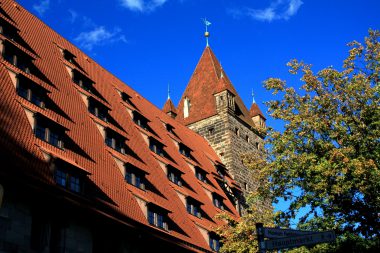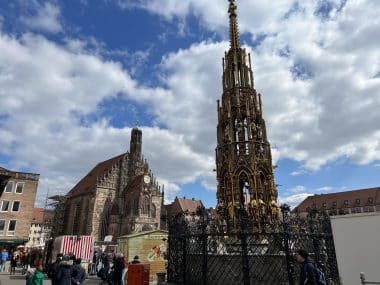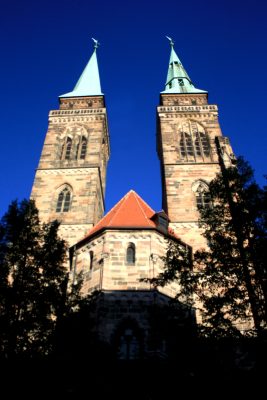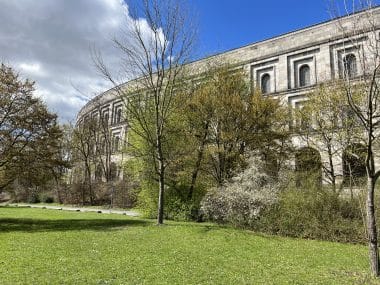Mulled wine, grilled sausages or Elisen gingerbread – the city of Nuremberg in the north of Bavaria, more precisely in Middle Franconia, has a lot to offer not only in terms of culinary delights. In 2018, Nuremberg set a new record in the tourism sector with 3.6 million overnight stays. Around 520,000 people live in Bavaria’s second-largest city. With an area of almost 187 km², there is also a lot to discover there. The old town and the Nuremberg Imperial Castle in particular are known far beyond the country’s borders and attract visitors from all over the world every year, regardless of the weather and the season. What sights are there to discover in Nuremberg? And what should you definitely do when visiting Nuremberg?
The history of Nuremberg
According to historical tradition, the traces of Nuremberg can be traced back to the year 850. It can therefore be assumed that the first settlements already existed in and around Nuremberg during this time. It became more concrete in 1050: Nuremberg was mentioned for the first time on a document (the Sigena document) with “nuorenberc” by Emperor Henry III. During this time, the well-known Imperial Castle and the Burgrave’s Castle in Nuremberg were also built, which were owned by the noble families Salier and Staufer, as well as the Burgraves of Raabs and Zollern.
At the time of the Second World War, however, the castle in Nuremberg was almost completely destroyed. During the National Socialist era, Nuremberg was an important city for the Wehrmacht and its functionaries. During this time, the large Nazi Party Rally Grounds, the Zeppelin Grandstand and the Congress Centre were built in the south of Nuremberg. Many parts of these buildings are still well preserved today and should definitely be visited during a stay in Nuremberg. These and other sights will now be discussed in more detail.
You have to see that in Nuremberg
Nuremberg Castle

At the top of the list is, of course, a visit to the Kaiserburg and the Burgrave’s Castle in Nuremberg’s old town. The paraphrase Nuremberg Castle refers to exactly these two castles. The first traces of the construction of the castles can be traced back to the year 1000. During the Second World War, both castles were almost completely destroyed in heavy air raids by the British and American air forces. However, Nuremberg Castle was completely rebuilt in the post-war years and continues to attract visitors from all over the world.
The Church of Our Lady
Just a five-minute walk from Nuremberg Castle is the Frauenkirche on the main market. This was completed in 1362 at the request of Emperor Charles IV after a ten-year construction period. In addition to the imposing construction, the Frauenkirche has another special feature: Every day at exactly 12 noon, high up under the clock, the Männleinlaufen takes place. At the beginning of this spectacle, two life-size fanfare brass figures raise their instruments at the edge. Afterwards, flute player, drummer and crier figures circle the emperor three times and disappear again inside the Frauenkirche. A beautiful spectacle that you should have seen during your stay in Nuremberg.
The Beautiful Fountain

The next attraction, the Beautiful Fountain, is also located directly on the main market. With its height of 19 meters, it is not only very high for a fountain, but immediately catches the eye of every visitor to the main market. The Beautiful Fountain was built between 1385-1396. The fountain itself consists of a total of 40 detailed and painted figures, which are intended to represent the world view of the Roman Empire with four floors. At the fountain itself there is a brass ring, which, according to legend, is said to bring good luck to anyone who turns the ring once.
The Sebaldus Church

Only 100 meters away from the main market is another church, the Sebalduskirche. In addition to the Frauenkirche and the Lorenzkirche, the Selbalduskirche is the third church that characterises the image of Nuremberg’s city centre. Built in the 8th century AD, it is the oldest parish church in all of Nuremberg. Inside the church is the tomb of Sebaldus, who served as the patron saint of Nuremberg. One of the remarkable things about the Sebaldus Church is that the furnishings are particularly well preserved to this day. A visit to this church is highly recommended.
Albrecht Dürer House
Between 1509, the Albrecht Dürer House in Nuremberg served as the home and workplace of the painter Albrecht Dürer, his family and his apprentices. Among his most famous works are the brown hare, the praying hands and the rhinocerus. Today, the house is freely accessible and has served as a museum since 1871 for visitors who want to find out more about the life and work of Albrecht Dürer. Many areas of the Albrecht Dürer House have been faithfully reconstructed.
The Toy Museum
We stay close to the main market. Not far from the market is the Toy Museum. Since 1971, the history of toys has been illuminated there in all its facets. Over 4000 objects can be viewed in the museum. But that’s by no means all: There are almost 80,000 other exhibits in the museum depot, which can be viewed via the Toy Museum’s homepage.
Germanic National Museum
The Germanisches Nationalmuseum is the largest museum in the German-speaking world in the field of cultural history. Around 25000 objects are exhibited in the museum. There are around 1.3 million objects in the depot of the Germanisches Nationalmuseum. The period of the exhibits on display ranges from prehistory and early history to contemporary art and culture.
The Nazi Party Rally Grounds

The last attraction worth visiting in Nuremberg is the Nazi Party Rally Grounds. This was to serve as a public propaganda area for the NSDAP during the Second World War. The area is located in the southeast of Nuremberg and is easily accessible from the city center by public transport. As early as 1923, work began on the first buildings on the Nazi Party Rally Grounds. The first was the municipal stadium, followed by the Luitpoldhalle, Luitpoldarena, Congress Hall, Zeppelin Field and Grandstand as well as the large street. Some of its sights, such as the Congress Hall, the Zeppelin grandstand and also the large street, are still well preserved today and worth a visit.
There is also a lot to discover in Nuremberg in terms of culinary delights
Culinary connoisseurs will also get their money’s worth in Nuremberg. Whether sweet or savoury: Nuremberg’s specialities offer something for every taste. If you want something hearty, you should definitely try the Nuremberg grilled sausages, which are offered there in a bun as “3 im Weggla”. “Saure Zipfel” (bratwurst cooked in onion broth) or the “Fränkische Schäuferle” (pork, served with a dumpling and sauerkraut) are also among the favourite dishes of many Nurembergers. And if you want something sweet, you will get your money’s worth with the original Nuremberg Elisen gingerbread and a warm cup of Nuremberg mulled wine.


